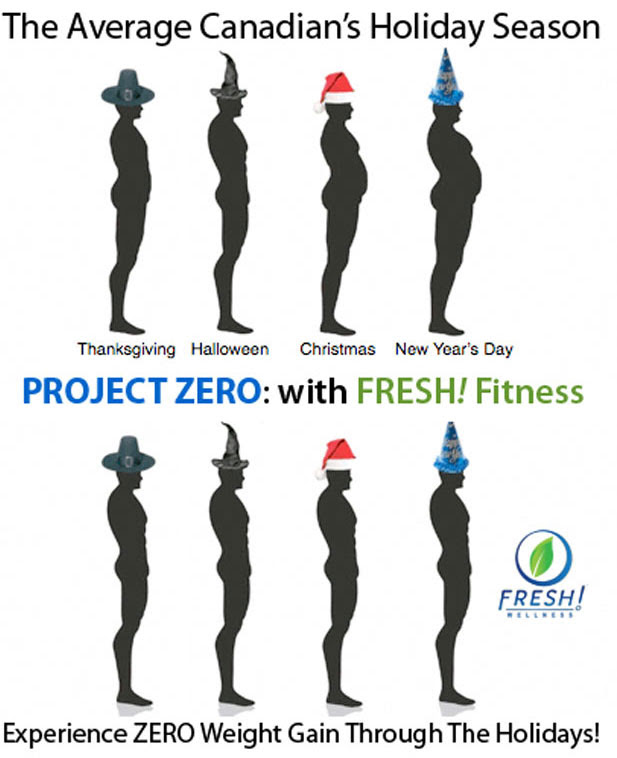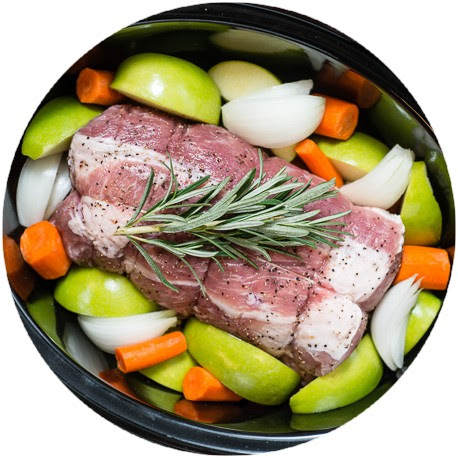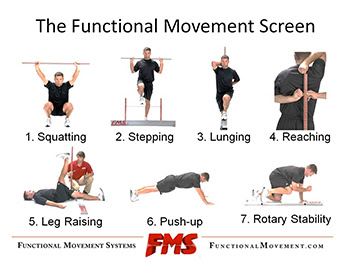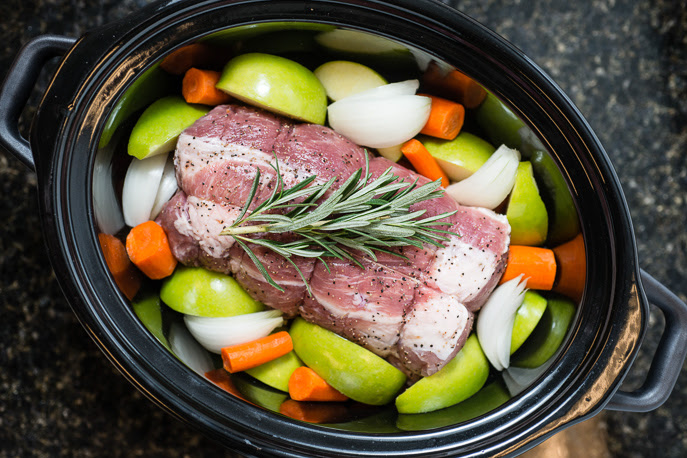
Hello!
Here's another great edition of the FRESH! Wellness Newsletter. This week, we have a tasty Slow Cooker Pork Roast with Apples, Carrots and Rosemary recipe for you to try. Plus, be sure to read our article on Upgrade Your Warm-Up . Dive in, enjoy, and please let us know what you think about the information.
To get the tips, tricks and tools necessary to succeed over the holidays, join our FREE Project Zero program. It started a few weeks ago, but you can jump in at any time.
Visit www.freshfitness.ca/projectzero to get started today.
On behalf of the FRESH! team, I want to wish you happy holidays and an amazing 2018. We look forward to seeing you in the New Year.
Yours in Health and Happiness,
Tim Borys
CEO
FRESH! Wellness Group


Upgrade Your Warm-Up
You might be tempted to skip the warm up when you work out. But warming up is a critical component of your fitness routine, and skipping it could have unpleasant and dangerous results.
See Article Below

Slow Cooker Pork Roast with Apples, Carrots and Rosemary
All you have to do is toss the pork loin in the slow cooker with some seasoning, fresh fruit and veggies. You’ll have a hot, nutritious meal for your family.
Check out the details below

Upgrade Your Warm-Up

You might be tempted to skip the warm up when you work out. After all, you only have so much time to exercise—“Let’s just get on with it already! I’m in a hurry!”
But warming up is a critical component of your fitness routine, and skipping it could have unpleasant and even dangerous results—such as muscle strain, muscle injury and pain.
Oh yeah, and a proper warm-up will actually IMPROVE your workout performance!
The Warm-Up: Basics
A warm up is a short workout period at the beginning of your exercise session. It is generally low intensity and prepares your body for the upcoming exertion.
The purpose of a traditional warm up is to slightly increase your heart rate. This raises your core body temperature and increases the blood flow to your muscles. Cold muscles and other connective tissues do not stretch very easily. A warm up session literally warms them up and relaxes them, making them more supple and ready to work.
Without a warm up, you will be more susceptible to sprained muscles, cramps and injury. Ultimately, these effects could keep you from exercising for an extended period of time as you recover, which is not conducive to the healthy lifestyle you desire.
It takes about three minutes for your body to realize that it needs to move more blood to your muscles, so the ideal warm up time is between five and ten minutes.
There is no set prescription for what your warm up should consist of. You can choose a set of preparatory exercises (such as squats, lunges, toe touches, etc.,) or you can do a light intensity version of your upcoming workout (a brisk walk to prepare for a run, for example, or lifting light weights before increasing the load).What causes a toxic liver?
Every day our bodies are bombarded by many different toxins, and it is primarily the job of the liver to handle this toxic load. These toxins can come from pesticides and chemicals used in the production of our food, environmental substances such as impure water and pollution, medications, artificial sweeteners, high amounts of animal fat and even caffeine and alcohol.
The Warm-Up: Advanced Strategy
Now with all that being said about a “basic” warm-up, let me share with you how I personally prepare myself, as well as every one of my personal training boot camp clients.
For long-term health and fitness combined with your weight loss training efforts it’s imperative to understand that a proper warm-up is about more than just “warming up the body.” It’s a about preparing the body for an all-out training assault that’s going to boost your metabolism through the roof.
Therefore, we look at the warm-up as a Preparation Phase for the workout to come. Through research and practical experience we’ve determined that best results are typically seen when an exercise prep routine incorporates 3 key components:
- Tissue Quality
- Corrective Exercise
- Mobility & Activation
Tissue Quality
Almost all chronic joint pain or overuse injuries are caused by tightness and restrictions in the muscles above and below the joint in question. In other words, it’s not about PAIN SITE… it’s about PAIN SOURCE!
Knee pain is often caused by restrictions in the tissue of your calves and front/inner/outer thighs. Back pain is often caused by restrictions in your glutes and hamstrings. Shoulder pain is often caused by restrictions in your thoracic spine (T-Spine), chest and lats.
Tissue quality describes the general health of your muscles and the interconnected web of fascia that surrounds them all. Over time, we develop scar tissue, adhesions, knots and trigger points due to high-intensity training, overuse, and/or extended periods of sitting.
The best way to address this is to self-massage sore, tight, and restricted muscle groups of the body to regenerate tissue both pre and post-workout to promote injury reduction and allow for a smoother, more productive workout.
In addition, self-massage before stretching allows for a better, more complete stretch by smoothing out the knots. You should always precede flexibility work with tissue quality for best results.
Massage is one of those counter-intuitive things whereby you are actually actively searching for pain. In fact, it’s the only time to ever do so when it comes to proper training.
The best analogy I can give you is this:
If it hurts that much when you put pressure on your muscles, just imagine how bad your joints must feel!
Corrective Exercise
We all have unique “issues” with our body mechanics and functional movement capabilities. For some it’s a lack of flexibility, while others there may be a balance or mobility issue. Perhaps there’s an asymmetry – one side is significantly “stronger” than the other leading to muscular imbalances, postural distortions and overcompensation injuries. You can find out your individual corrective needs by going through a movement screen such as the Functional Movement Screen (FMS).
The FMS is a ranking and grading system that documents movement patterns that are key to normal function. By screening these patterns, the FMS readily identifies functional limitations and asymmetries. These are issues that can reduce the effects of functional training and physical conditioning and distort body awareness.
The FMS generates the Functional Movement Screen Score, which is used to target problems and track progress. This scoring system is directly linked to the most beneficial corrective exercises to restore mechanically sound movement patterns.
Exercise professionals monitor the FMS score to track progress and to identify those exercises that will be most effective to restore proper movement and build strength in each individual.
So, in a nutshell, the FMS is designed to
- Identify functional limitations and asymmetries which have been linked to increased injury risk
- Provide exercises to restore proper movement, and build stability, mobility, and strength in each individual
Mobility & Activation
More than just a typical warm-up, a mobility and activation circuit truly prepares your body for a maximum performance workout.
Mobility describes the ability of a joint, or a series of joints, to move through an ideal range of motion. Though mobility relies on flexibility, it requires an additional strength, stability, and neuromuscular control component to allow for proper movement. Activation is often paired with mobility because many mobility exercises activate key, and often dormant, pillar stabilizers in your hips, core and shoulders.
More Than Just a Warm-Up…
So, as you can see, a warm-up is much more than just a warm-up when you’re training smarter for long-term health, fitness and fat loss goals.Think twice before you skip the “warm-up” in your next workout…

Featured Quote

Slow Cooker Pork Roast with Apples, Carrots and Rosemary

4 servings
Ingredients
- 2 Granny Smith apples, cored and each cut into 8 wedges
- 1 TBSP lemon juice
- 4 lb. boneless loin pork roast
- 1 tsp. salt
- ¼ tsp. fresh ground black pepper
- 1 medium onion, cut into eighths
- 4 large carrots, cut into 1-½” pieces
- 1 sprig fresh rosemary
Directions
In medium bowl, toss apples with lemon juice, set aside. Season roast with salt and pepper. Please half of onions and 4-6 apple wedges in bottom of slow cooker. Top with seasoned roast, surround with remaining apples, onions and carrots. Top with rosemary. Cover and cook on high for 4 hours, medium or 5-½ hours or low 7-8 hours.
Note: For food safety, be sure to cook until meat thermometer registers at least 160°F
Original Recipe from Everyday Good Thinking
Tip of the Week: Mood Boosters
You overslept, burnt your toast, the dog peed on the floor, it's raining, and you were late for work. Seemingly small things, but now you're in a bad mood and having one of those days. Or maybe everything's going fine but it's like you woke up on the wrong side of the bed and can't seem to shake your bad mood.
While you may just want today to be over so you can start fresh tomorrow, it's time to start living in the now. Change your attitude, refocus, and start looking on the bright side with these eight simple mood-boosting ideas.
#1 Be Thankful. Take your eyes off yourself and put them on the good in your life. Focus on the good rather than the bad. Keep a running list of what you have to be thankful for, no matter how small or insignificant they seem.
#2 Let in the Light. Being cooped up indoors all day can put anyone in a bad mood. However, did you know that sunlight can brighten your day and outlook on life? Open the curtains in the morning, take a walk outside during your lunch break, or just sit by an open window. Just let in the light!
#3 Connect With Others. They say laughter is the best medicine, so surround yourself with people who make you happy. Call up a friend who makes you laugh, spend quality time with your kids, or go on a date with your spouse. Another great mood booster is hugging. Human touch triggers your brain to produce endorphins that relax your body and relieve stress.
#4 Get Moving. Like human touch, exercise releases feel-good endorphins. A brisk walk around the neighborhood, a jog on the treadmill, or an intense basketball game at the gym are proven ways to shake a bad mood for at least 12 hours.
#5 Listen to Music. Research shows music has a powerful effect on changing or reinforcing your mood. When you're feeling blue, sad, or grouchy, try listening to some of your favorite upbeat tunes and see how your mood changes.
#6 Play with Your Pet. Playing with your pets is a great way to relax, refocus, and boost your mood. A few minutes spent petting your dog or cat releases hormones that lower your body's production of the stress hormone cortisol.
#7 Volunteer. When you give your time or resources to make a positive difference in someone's life, you feel better about your own. Serving a meal at a homeless shelter, raking an elderly neighbor's leaves, or making a meal for a sick friend are simple ways to not only brighten someone else's day, but your own as well.
#8 Choose Your Food Wisely. Don't underestimate the role of your diet when it comes to your mood. What you eat and drink can either improve or harm your state of mind. Some foods give you a boost (omega-3 fatty acids, whole grains, and protein) and others make you feel sluggish and depressed (junk food and empty carbs).



FRESH! Wellness Group
18th Floor 734-7th Avenue SW Calgary, Alberta T2P 3P8 Canada (403) 217-2730